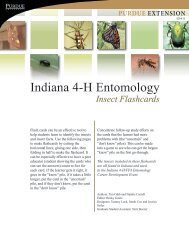Pink Gypsy Moth - aphis - US Department of Agriculture
Pink Gypsy Moth - aphis - US Department of Agriculture
Pink Gypsy Moth - aphis - US Department of Agriculture
You also want an ePaper? Increase the reach of your titles
YUMPU automatically turns print PDFs into web optimized ePapers that Google loves.
Appendix C. Taxonomy and morphology <strong>of</strong> Lymantria mathura<br />
Synonyms<br />
Portheria mathura (Moore)<br />
Ocneria mathura (Moore)<br />
Lymantria aurora Butler<br />
Lymantria fusca Leech<br />
Lymantria mathura aurora Butler<br />
Diagnostic features<br />
For complete accuracy, the following morphological descriptions <strong>of</strong> L. mathura are<br />
quoted from Moore (1865) and Roonwal (1979b).<br />
Lymantria mathura<br />
“Lymantria mathura Moore (Lepidoptera : Lymantriidae) is a moderate sized moth...<br />
There is marked sexual dimorphism in size and colour. The male is smaller (wing<br />
expanse male: 35-50mm; female: 75-95mm), with the forewings brown and hindwings<br />
yellow. In females the forewings are white with dark markings, and the hindwings<br />
pink...”(Roonwal 1979b).<br />
Male<br />
“Upperside-fore wing greyish white, markings brown, with pale-brown interspaces; with<br />
two or three black and yellow spots at the base; two transverse subbasal irregular lines,<br />
between which is a broad band; a round spot within the cell and a blackish curved streak<br />
at its end; three transverse discal lunulated bands, the first broad, the others narrow; a<br />
marginal row <strong>of</strong> spots: hind wing dull yellow, with a blackish discal spot, narrow<br />
submarginal maculated band, and a marginal row <strong>of</strong> small spots. Underside dull yellow,<br />
suffused with pale brown between the veins, with darker-brown discal and marginal<br />
spots. Thorax white, with yellow and black spots. Abdomen yellow, tuft white, with<br />
dorsal, lateral, and a row beneath <strong>of</strong> black spots. Head at the sides, palpi in front, and legs<br />
yellow; palpi above and at the sides, and spots on the legs, black. Antennae brown.<br />
Expanse 2¼ inches” (Moore 1865).<br />
“Egg-masses and covering hairs”<br />
Egg masses are laid from ground-level up to about 18 m (60 ft.) <strong>of</strong> the trunk, but are most<br />
dense between the levels <strong>of</strong> 0.5 to 5 m. They are flat, <strong>of</strong> an ovoid-elongate or other<br />
shape, with irregular edges, and vary in extent from about 0.5 x 1 cm to 6 x 15 cm. From<br />
a distance the egg masses are visible as characteristic white, fluffy patches against the<br />
dark-coloured bark. Each egg-mass contains about 50 to 1,200 or more eggs which are<br />
laid 2 to 4 layers deep directly on the bark. An egg-mass is covered over with a nearly<br />
one-millimetre, white thick felt-like covering composed <strong>of</strong> long, white, silken hairs. (...<br />
these hairs are shed by the female from the anal tuft. ... ) The hairs are about 800-1200 µ<br />
long and 3.1-6.2 µ in diameter; one end is knob-like, the other pointed; a few such hairs<br />
are also mixed with the eggs. Freshly laid eggs are rounded, have a flat base, the<br />
CAPS PRA: Lymantria mathura 20
















